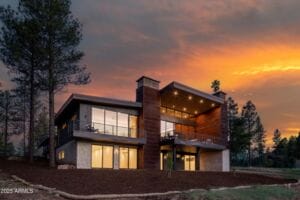What do you get when a prominent property management association and global commercial investment association join forces to predict what’s ahead for 2018?
The annual Institute of Real Estate Management (IREM) and Certified Commercial Investment Member (CCIM) Economic Forecast is the answer and the byproduct is a half-day of thoughtful discussion, analysis and outlooks for Arizona’s commercial real estate market.
Now in its 11th year, the conference yielded insights and expertise from the best minds in real estate and the mavericks leading innovation, which were broken up into special panels for each product type (industrial, office, multifamily and retail).
The general theme was positive for each sector although some are showing more favorable indicators for increased investment and development in the year ahead. To kick things off, Dr. Barry Asmus, a senior economist for the National Center for Policy Analysis and adjunct professor at Grand Canyon University, gave a macro-economic overview.
Dr. Asmus called the newly approved tax reform “long overdue” and described how the marginal tax rate was 70 percent for the last five decades, which produced very low economic growth. He predicts positive market activity as a result of the new tax law changes.
Before closing his keynote speech, Dr. Asmus also mentioned the United States’ $50 trillion lottery ticket.
He said, of the 3.5-million square miles of land that makes up the United States, the federal government owns about one-third, which is extremely rich with natural gas. Estimates put the natural gas reserves’ value at approximately $50 trillion, which Dr. Asmus said, could eliminate the country’s national debt if the U.S. decided to become a net energy exporter of natural gas.
The focus shifted back to Arizona during the industrial, office, multifamily and retail panels that followed.
Industrial: The fourth revolution
Industry veteran Pete Bolton moderated the panel of industrial heavy hitters that described the market as balanced and positive overall.
Pat Feeney, senior vice president at CBRE Phoenix, said all but three of the 28 industrial submarkets it follows experienced growth in the last few years, adding that it “feels balanced going forward.”
Currently, Metro Phoenix’s industrial vacancy is at 6-percent and the panelists agree there’s room for growth in pricing. Also keep an eye on more speculative developments coming online, especially for e-commerce tenants, which are now seeking minimum 40-foot clear heights.
For instance, the 901,700-square-foot Lincoln Logistics 40 under construction in Goodyear by Lincoln Property Company is Arizona’s first spec-build with 40-foot clear heights, says David Krumwiede, regional partner at LPC.
He predicts more vertically integrated big-box, industrial spec-builds that utilize mezzanines, conveyer systems and automation as a way to save because rents are based on price per square foot. The panelists called this tech-influence in new space as the fourth industrial revolution in the U.S.
In terms of small/medium-sized industrial products (1-15K SF), Leroy Breinholt, president and designated broker at Commercial Properties, Inc., predicts a jump in price between the next 12-18 months because of a lack of supply of owner/user type buildings available.
“Red hot” is how Will Strong, executive managing director at Cushman & Wakefield, described the market. In addition to recent portfolio aggregations, he also noted the design trend to go vertical, specifically a multi-story warehouse in Seattle.
Office: Higher rents, lower supply, more demand
The local market continues to see an inflow of companies relocating here as well as expanding, which has boosted rent rates by 3.5 percent over the last three years.
Moderated by Scott Fey, partner and principal at Omni American, the panel gave the overall office market a “green light,” signaling good times ahead.
Currently more than 758 technology companies are located in Metro Phoenix, which Barry Barry Gabel, executive vice president at CBRE, said, is very close to being recognized as a 24-hour city after recently jumping up to “core market” status.
As a result, this former secondary/tertiary market known as Phoenix, is now seeing demand outpace supply, says Mark Seale, managing director at Avison Young.
Molly Ryan Carson, vice president of real estate development at Ryan Companies, noted Chandler is hot with speculative development, including a current project by VanTrust Real Estate. Ryan Companies is also building its first spec-development in over eight years at a site adjacent to the new McKesson campus in South Scottsdale.
In terms of medical office buildings (MOBs), Marina Hammersmith, senior vice president at Ensemble Real Estate Solutions, describes healthcare as more of a “consumer experience” than ever before. The biggest shift in healthcare is its “hub and spoke model,” where the hospitals serve as the hub and the MOBs and clinics serve as the spokes that extend into the surrounding communities, she explained.
Multifamily: Hot, no changes on horizon
No surprise here as everyone on the panel predicts the multifamily market will stay hot and no fundamental changes are on the horizon in terms of design, leasing strategies or new amenities.
However, the single-family for rent concept is starting to catch on more around the Valley as described by Josh Hartmann, executive vice president for NexMetro, which was started in Phoenix. Essentially, the communities operate like a traditional multifamily apartment complex but the units are designed like a smaller, detached, single-family home with a yard.
Cliff David, managing director at Cushman & Wakefield, noted a survey that found 65-percent of Millennials rent, which is the highest rate ever.
Millennials are not the only ones moving into new multifamily projects though as more Gen x and Baby Boomers downsize or relocate to a more densely populated urban cores.
Retail: Brick-and-mortar demand remains
Moderated by Patrick McGinley, president of management services at Vestar, the panel agreed that the “retail-apocalypse” was exaggerated and the demand for brick-and-mortar retail is exists.
Yes, the e-commerce market share is growing, accounting for 8.5-percent of all retail sales last year.
That’s why Rommie Mojahed, director of retail leasing and sales investments at SVN Desert Commercial Advisors, is turning increased attention to more service- and entertainment-oriented tenants to occupy vacant retail center spaces.
“We are looking for ‘activator tenants’ that will drive traffic and that are Internet-proof,” explained Mojahed, such as healthcare clinics, gyms, dentist offices and theatres.
In terms of large retail power centers, Michael Hackett, executive managing director at Cushman & Wakefield, noted the Amazon effect caused asset values to drop, but the centers actually started performing better in 2017 compared to when the assets were worth more.
The number one killer to retail centers is when the anchor tenant moves out, explained Walt Brown Jr., founder, CEO and designated broker at Diversified Partners, who also noted how important property managers are to keeping tenants successful and happy.
Despite the headlines last year about store closures and bankruptcies, Hackett noted, every single segment in retail expanded in 2017 with the exception of department stores, which remained flat.
Expect more retailers to open shop in 2018 too despite more e-commerce sales.
Jerry Colangelo Impact Award
This year, Nick Miner, CCIM, senior vice president of investments at ORION Investment Real Estate, presented the 2018 Jerry Colangelo Impact Award to Drew Brown, co-founder and chairman of the board for DMB.
More details about the event and panels can be found here.



